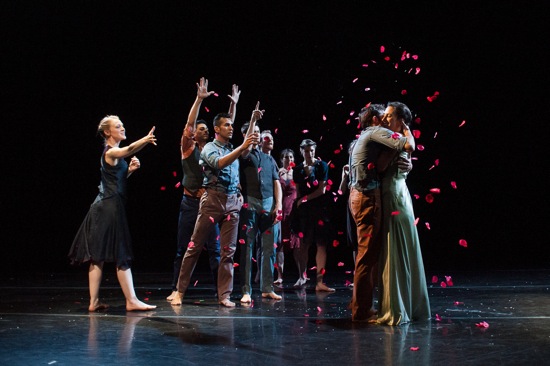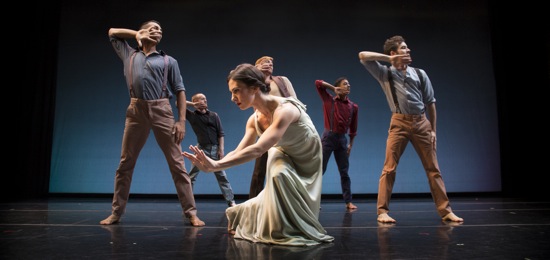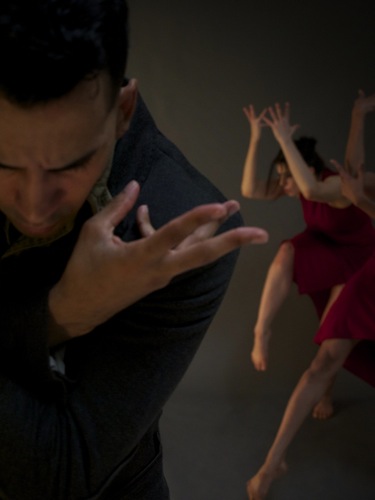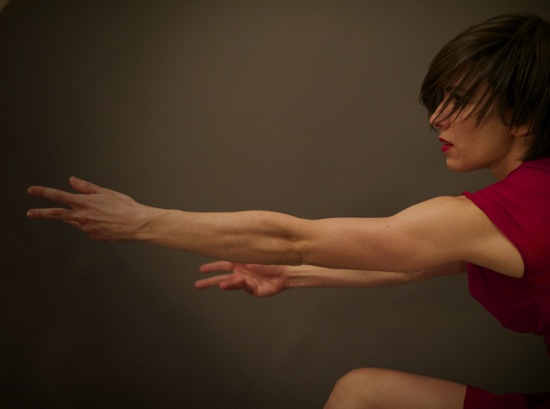
BODYTRAFFIC in Barak Marshall’s And at midnight, the green bride floated through the village square. . .Foreground: Tina Finkelman Berkett and Guzman Rosado. Photo: Christopher Duggan
In 2007, two women, Lilian Barbeito, a Juilliard graduate, and Tina Finkelman Berkett, an alumna of the Barnard College’s dance department, founded a contemporary dance ensemble in Los Angeles. What are the chances of that endeavor failing in a balmy city where it takes nerve, courage, and good business sense for a dance company to nose its way out of the prevailing motion picture culture? Iffy at best, but BODYTRAFFIC has flourished in Los Angeles and made itself known at festivals in the U.S. and Canada. In 2013, Dance Magazine included it in its “25 to Watch” lineup.
You can see why. The company’s ten dancers are wonders—lithe, flexible, powerful, daring. And Barbeito and Berkett have made some interesting choices in commissioning choreographers. The Jewish backgrounds that they have in common have inspired some of those choices. Barak Marshall, now the artistic director of Inbal Dance Theatre, is responsible for three works in BODYTRAFFIC’s repertory. Dust, a world premiere during the company’s January season at the Joyce Theater, is the work of Hofesh Shechter, who maintains his own company in the U.K.
BODYTRAFFIC appears alternately at the Joyce with Doug Elkins’s company during the hectic week of the APAP conference (Association of Performing Arts Presenters), when you can find showcases tucked into every available performing space from morning until late night. So there may have been some bleary eyes in the audience at the first performance, but the applause was as vociferous as could be hoped for.
That said, I admit to being not only engrossed, but also puzzled or restless during parts of the dances on the program: a substantial excerpt from Marshall’s And at midnight, the green bride floated through the village square. . ., Victor Quijada’s Once Again Before You Go, Richard Siegal’s The New 45, and Dust. At times, a choreographer would seem to be repeating himself or drawing out an idea to a point at which you could easily fall out of love with it. At other times, a dance ended and you might feel like saying, “huh?” As in, what just happened?

A scene from Barak Marshall’s And at midnight, the green bride floated through the village square. . .Foreground: Tina Finkelman Berkett. Photo: Christopher Duggan
The green bride excerpt begins with Berkett alone down center, clasping a bouquet and staring around. No groom announces himself and no wedding. At least, not exactly. Sequences of vehement dancing for the ensemble or the men or the women keep cropping up between scenes that portray dissent between the sexes or misogynistic behavior by the guys. All this is borne along by music that ranges from the Abaca String Band to the Barry Sisters’ “Chiribim Chiribom” to Zoltan and His Gypsy Ensemble to the singing of Margalit Oved (once herself the director of Inbal, its greatest performer, and Marshall’s mother).
The passages of dancing—usually performed facing front and in unison—are composed primarily of hand and arm gestures, executed with staccato precision, while the dancers’ step, turn, bend, and straighten, traveling only minimally from their appointed places. You’re aware of elbows jutting out, wrists flexing. A gutsy energy suffuses the movement; this could be a group soliloquy grafted onto a folk dance. Although the gestures fly by, you can read almost read some of them (“go away!” “oh my God!” “I don’t want to see it”); others pantomime acts such as taking a quick drink).
The intervening episodes call to mind Pina Bausch’s work. In one of several related scenes, Bynh Ho and Michele Carter stand at a mike, and he describes preparing a possible meal with a voluptuous greed that has her turning weak at the knees, before he calls a halt. In another vignette, a man sits on a bench, pretty much concealed behind the newspaper he’s reading. One by one, the women (Berkett, Carter, Melissa Bourkas, Merett Miller, and Gina Lewis) don high heels and snuggle up beside him, trying to charm him. After a few seconds, two men standing behind the bench tip each woman backward and lay her on the floor behind the bench; her open bent legs are in the air, and her crotch is toward the audience. By the time the sequence is over, there’s a row of women on display with bits of paper (or petals) scattered around them. A seconds-long travesty of a marriage repeated over and over, with each woman eager to take a turn.
This is all intriguing, but after a while, when the dancing returns several times with the same emphatic vocabulary, my interest wanes. I wish I could see the whole piece and understand more about that floating bride and the family or society she’s part of.
Shechter’s Dust is mystifying in a different way. I’m assuming the title refers to the biblical pronouncement, “dust thou art, and unto dust shalt thou return,” and intermittently a robotic voice-of-God makes announcements (this voice sounds slowed down, but it maintains its creepiness even when it eventually speeds up into near intelligibility). The score (also by Shechter) often sounds punitive; at times, buried voices mutter inside it. In the beginning, a lone man, spotlit in darkness (Guzmán Rosado, I believe) writhes and jerks. Hunched-over and pinched-in, he looks as if his guts need protecting and as if he hurts, either from pain or guilt. Later, everyone will move like this for a while.
There are three men in Dust (Miguel Perez, Rosado, and Andrew Wojtal) and three women (Berkett, Carter, and Bourkas). The men wear dark suits, the jackets unbuttoned to reveal white shirts. The women wear red dresses (designed by Linda Chow and the company). Designer Chahine Yavroyan creates some stunning effects—pinning the dancers in pools of light, creating rays that cross transversely on diagonals, turning the backdrop blue.
The movement is big and bold. The dancers advance spraddled-legged, knees bent; they fling their legs like weapons. They move in squadrons—sometimes as one, once in antiphonal groups. Vigorous. Powerful. Together, yet isolated. “My life is a desert,” the voice says over and over at one point. Is this war? Is it indeed life? What kind of community do these well-dressed people belong to? “In the end there was. . .” says the voice. The lights go out. Is this what those images of self-involved struggle and fierce dancing led to? I guess by the time we’re dead, it’s too late to say “death” (or, if you prefer, “heaven”).
Berkett appears in all of the four works shown at the Joyce, and you can’t blame the choreographers for wanting her to grace their dances. She’s remarkable—subtle in her command of dynamics and deeply committed to the moment. She’s the only woman in Quijada’s quartet Once Again, Before You Go (set to music by Jasper Gahunia), and the only woman in Siegal’s trio The New 45.
Quijada danced with several companies before founding his own RUBBERBANDance Group in 2002, but his earliest experience of dance was hip-hop, and the twisty athleticism of that style underlies his piece for BODYTRAFFIC. The title can (slyly) refer to another go at sex, another round of drinks, or one more scuffle. But eroticism doesn’t play much of a part. The men (Brandon Alley, Ho, Rosado, and Wojtal) saunter onto the stage, prepared to join in athletic duets that, in their complexity, look like tests of skill and cooperation rather than fights; a drop to the floor only means more tricky grappling. Berkett, coming and going, is not like West Side Story’s “Anybodys”—shunned by the boys she wants to join. She’s as acrobatic as they are and, apparently, as nonchalant.
The end comes as a shock. Suddenly, the stage goes dark, and a spotlight picks out Berkett; she’s off the ground (perhaps seated on someone’s shoulders) with the others clustered around her. Only her face and the upper part of her body are lit, as if in a beam from heaven. Did I miss something? How did she get to be queen of the neighborhood?
Siegal runs his own European company, The Bakery Paris-Berlin (2005), in addition to creating works for numerous other groups. The New 45 coasts and springs and wriggles along to a medley of ingratiating tunes. We get to hear Oscar Peterson, Clark Terry, Harry Belafonte, Marc Blitzstein, Harold Arlen, and a tricky, instrumental, jazzed-up version of the Berthold Brecht/Kurt Weill “Mack the Knife.”
No credit for costumes is given in the program, and the dancers’ attire is the only awkward element in this lively work for Berkett, Rosado, and Wojtal, with clever lighting by Mitchell Bogard. The men’s relationship veers from helpful to punitive, but all three performers are out for a good time, letting the jazzier musical numbers limber up their hips or send them bursting exuberantly into the air. Siegal has made an engaging duet to the Weill music for Berkett and Rosado, which is followed by vivid solos by each. Naturally, Wojtal arrives to horn in and toss off a bit of soft shoe. It’s nice that the three give the impression of showing off for themselves and each other, rather than trying to wow us. And the ending song by Arlen that most of us know so well urges everyone to “come on, get happy!” So we do.
BODYTRAFFIC will perform at Jacob’s Pillow in July. I look forward to seeing these terrific dancers again.



The dancers I know of who are graduates of Barnard College, my alma mater, were not dance majors, for back in the last millennium, there was no dance department there. Twyla Tharp majored in art history; Elizabeth Keene in religion. So I am as bemused by Berkett’s degree as I am by the success, artistic and otherwise, of a contemporary dance company in L.A., where classical ballet has also struggled mightily over the years. Thank you, Deborah, for piquing my interest in this company, and for using the word “punitive” to describe Schechter’s score; I know just what you mean.
Thank you for your input. Tina Berkett seems to me to be young enough to have attended Barnard when a major in dance was possible. But you have rightly nudged me in the right place (my Achilles Heel as a historian). Perhaps she majored in some other subject. We shall see
Berkett was a Math and Economics major
I currently teach Dance Composition at Barnard and my classes are a mix of dance majors and people with other majors. There are a number of excellent dancers at Barnard, though not all of them are majors, and at least 4 of them have worked with me in my company over the years. I also teach at Juilliard so I’m especially glad to see this company thriving.
Hi Deborah, just to elaborate on your astute comment concerning the costumes in Richard Siegal’s The New 45: they were indeed not the original costumes that went with the piece, which, by the way, was always a duet for 2 men (they did it at City Center’s Fall for dance several years ago where it was a smash hit!). Richard decided to change the costumes for BodyTraffic’s “premiere” but did not get to see them since he was back in Paris. So yes, I am sure after several suggestions were made, including mine and Mitchell’s, the company will go back to more of the brown, tan, grey pants and shirts that were a casual-yet-elegant look. Thanks.